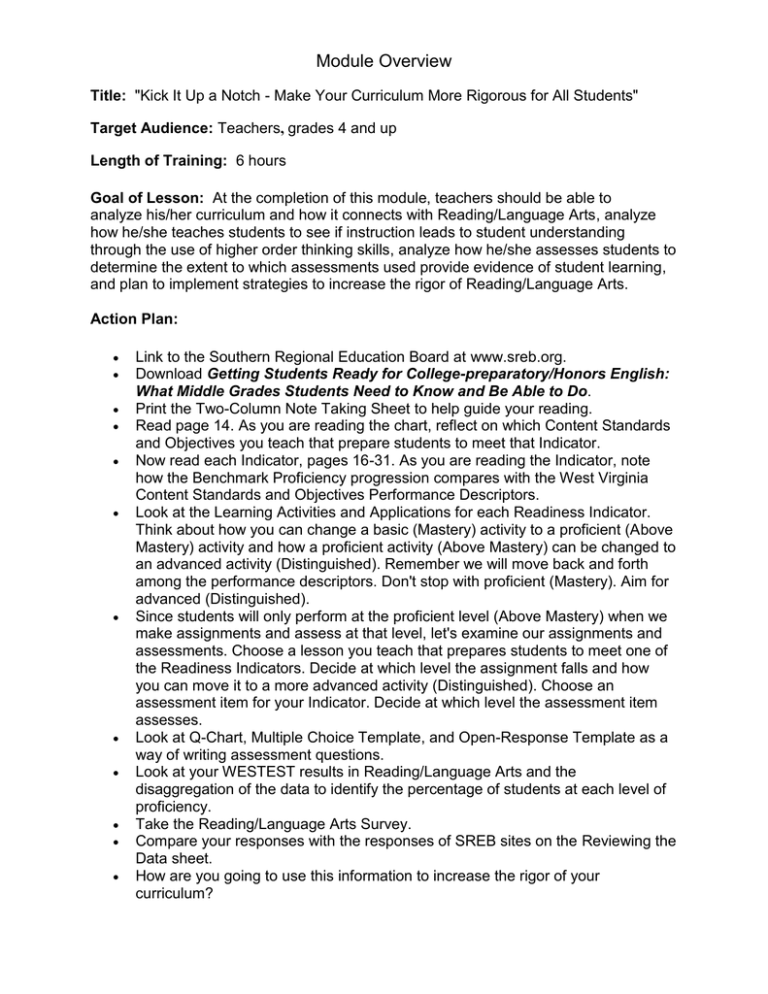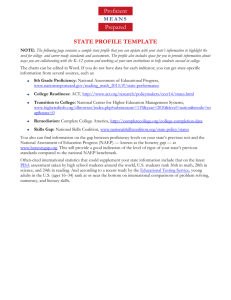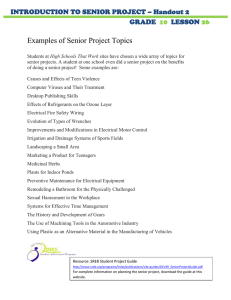Module Overview
advertisement

Module Overview Title: "Kick It Up a Notch - Make Your Curriculum More Rigorous for All Students" Target Audience: Teachers, grades 4 and up Length of Training: 6 hours Goal of Lesson: At the completion of this module, teachers should be able to analyze his/her curriculum and how it connects with Reading/Language Arts, analyze how he/she teaches students to see if instruction leads to student understanding through the use of higher order thinking skills, analyze how he/she assesses students to determine the extent to which assessments used provide evidence of student learning, and plan to implement strategies to increase the rigor of Reading/Language Arts. Action Plan: Link to the Southern Regional Education Board at www.sreb.org. Download Getting Students Ready for College-preparatory/Honors English: What Middle Grades Students Need to Know and Be Able to Do. Print the Two-Column Note Taking Sheet to help guide your reading. Read page 14. As you are reading the chart, reflect on which Content Standards and Objectives you teach that prepare students to meet that Indicator. Now read each Indicator, pages 16-31. As you are reading the Indicator, note how the Benchmark Proficiency progression compares with the West Virginia Content Standards and Objectives Performance Descriptors. Look at the Learning Activities and Applications for each Readiness Indicator. Think about how you can change a basic (Mastery) activity to a proficient (Above Mastery) activity and how a proficient activity (Above Mastery) can be changed to an advanced activity (Distinguished). Remember we will move back and forth among the performance descriptors. Don't stop with proficient (Mastery). Aim for advanced (Distinguished). Since students will only perform at the proficient level (Above Mastery) when we make assignments and assess at that level, let's examine our assignments and assessments. Choose a lesson you teach that prepares students to meet one of the Readiness Indicators. Decide at which level the assignment falls and how you can move it to a more advanced activity (Distinguished). Choose an assessment item for your Indicator. Decide at which level the assessment item assesses. Look at Q-Chart, Multiple Choice Template, and Open-Response Template as a way of writing assessment questions. Look at your WESTEST results in Reading/Language Arts and the disaggregation of the data to identify the percentage of students at each level of proficiency. Take the Reading/Language Arts Survey. Compare your responses with the responses of SREB sites on the Reviewing the Data sheet. How are you going to use this information to increase the rigor of your curriculum? Let's compare your responses to the Process Readiness Indicators on page seven of Getting Students Ready for College-preparatory/Honors English: What Middle Grades Students Need to Know and Be Able to Do. These are quantity indicators recommending how much students should do. Note the number of each type of reading material listed on page eight. ACTIVITY 1: Knowledge Rating - You will describe your expertise with a variety of reading strategies. ACTIVITY 2: Setting a Purpose for Reading - You will read a passage, then reread it with a specific purpose and compare the knowledge you gained and the strategies you used. ACTIVITY 3: Anticipation Guide - You will learn how a simple set of statements can set a purpose and motivate students to read. ACTIVITY 4: KWL Chart and Read Aloud - This graphic organizer can be used to help students focus on specific information in text. Read Aloud will provide your students with valuable prior knowledge. ACTIVITY 5: THIEVES- Strategy for Previewing Text - Help your students "steal" meaning from their text by using this strategy. ACTIVITY 6: Reading Strategy for Non-fiction Text - This Mental Model will help students look at their text in a new way. ACTIVITY 7: Choose & Use a Before Reading Strategy - In this activity you will reflect on the pre-reading strategies from activities 1-6 and plan for implementation in your classroom. ACTIVITY 8: Think Aloud - You will learn how to let students see what you are thinking as you interact with text. ACTIVITY 9: Double Entry Journal or Two Column Notes - These strategies help students understand text by allowing them to "note" their questions or comments as they read. ACTIVITY 10: Paired Reading - Having students read with a partner requires more concentration than having one class member read while the others listen. Learn some hints for implementing this strategy. ACTIVITY 11: Learning Tree - This graphic organizer can be used to create a study guide for any chapter of text. ACTIVITY 12: Question Bookmark Using Bloom's Taxonomy - You will see examples of higher order thinking questions to use with your students. ACTIVITY 13: Structured Note Taking - Help your students decide what is important in text by using this strategy. ACTIVITY 14: Choose & Use a During Reading Strategy - In this activity you will reflect on the during reading strategies from activities 8-13 and plan for implementation in your classroom. ACTIVITY 15: Response Sheet - Help your students reflect on their reading by using this strategy. ACTIVITY 16: AlphaBoxes - Use this graphic organizer to review concepts and vocabulary covered in a text chapter or unit. ACTIVITY 17: Questioning - Students can reflect on their reading by asking and answering reflective questions. ACTIVITY 18: Discussion Web - Use this graphic organizer to foster a deep reflection on an issue from the text. ACTIVITY 19: Exit Slip - Hold your students accountable for describing what they learned in class today by using this strategy. ACTIVITY 20: Mind Map - Use this graphic organizer to see if students really understand major literary characters or famous people in history. ACTIVITY 21: Choose & Use an After Reading Strategy - In this activity you will reflect on the after reading strategies from activities 15-20 and plan for implementation in your classroom. ACTIVITY 22: Wrap Up - You will compare your Knowledge Rating from Activity 1 with what you now know. Facilitator’s Notes: Facilitators divide the participants into six groups. Present each group with a sheet of chart paper and markers so each group can visually illustrate a readiness indicator: a. Develop vocabulary appropriate to reading, writing, and speaking proficiency. b. Summarize, paraphrase, and categorize information. c. Compare and contrast information, ideas, and structures to clarify meaning of various materials. d. Make inferences and predictions. e. Connect what is read to personal experience and the world beyond the classroom. f. Identify and interpret literary structures, elements, devices, and themes. Each group reports to the whole group. Discuss how the Content Standards and Objectives relate to the readiness indicators. Discuss how the Performance Descriptors relate to the Benchmark Proficiency progression. Discuss how the Learning Activities and Application can be kicked up a notch. Discuss how this activity touched on each Indicator in about the same amount of time it would have taken to read all of them individually. Discuss how participants can use this activity in their own classrooms. Choose a lesson you teach that prepares students to meet one of the Readiness Indicators. Decide at which level the assignment falls and how you can move it to a more advanced activity. Choose an assessment item for your indicator. Decide at which level the assessment item falls. Use Q-Chart, Multiple Choice Template, and Open-Response Template as a way of writing assessment questions. Use WESTEST Reading/Language Arts results to identify the percentage of students at each level of proficiency. Conduct a Walk Around addressing the questions listed in the survey. Compare this group's responses with those of the SREB sites as reflected on the Reviewing the Data sheet. Have participants discuss how they can use this information to increase the rigor of their curriculum. Training Developed by: All materials used in this activity were taken from the booklet called Getting Students Ready for College-Preparatory English: What Middle Grades Students Need to Know and Be Able to Do, published by the Southern Regional Education Board 592 10th Street, N.W. Atlanta, GA 30318 www.sreb.org Research: The 2001 No Child Left Behind Act and state accountability programs illustrate the need for improving achievement in Reading. All states and schools are expected to provide students with experiences which will lead them to perform at the proficient level or above in reading. This module will assist teachers in creating quality experiences for their students.





